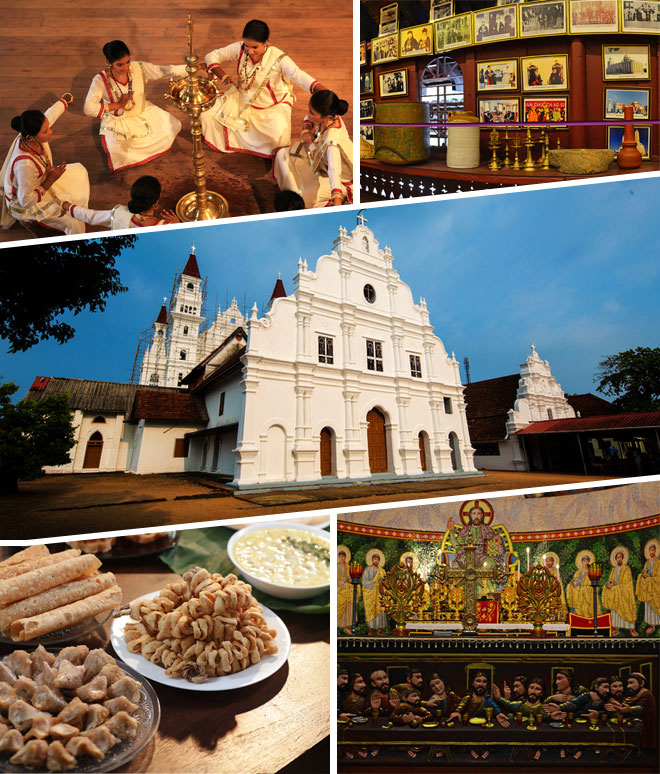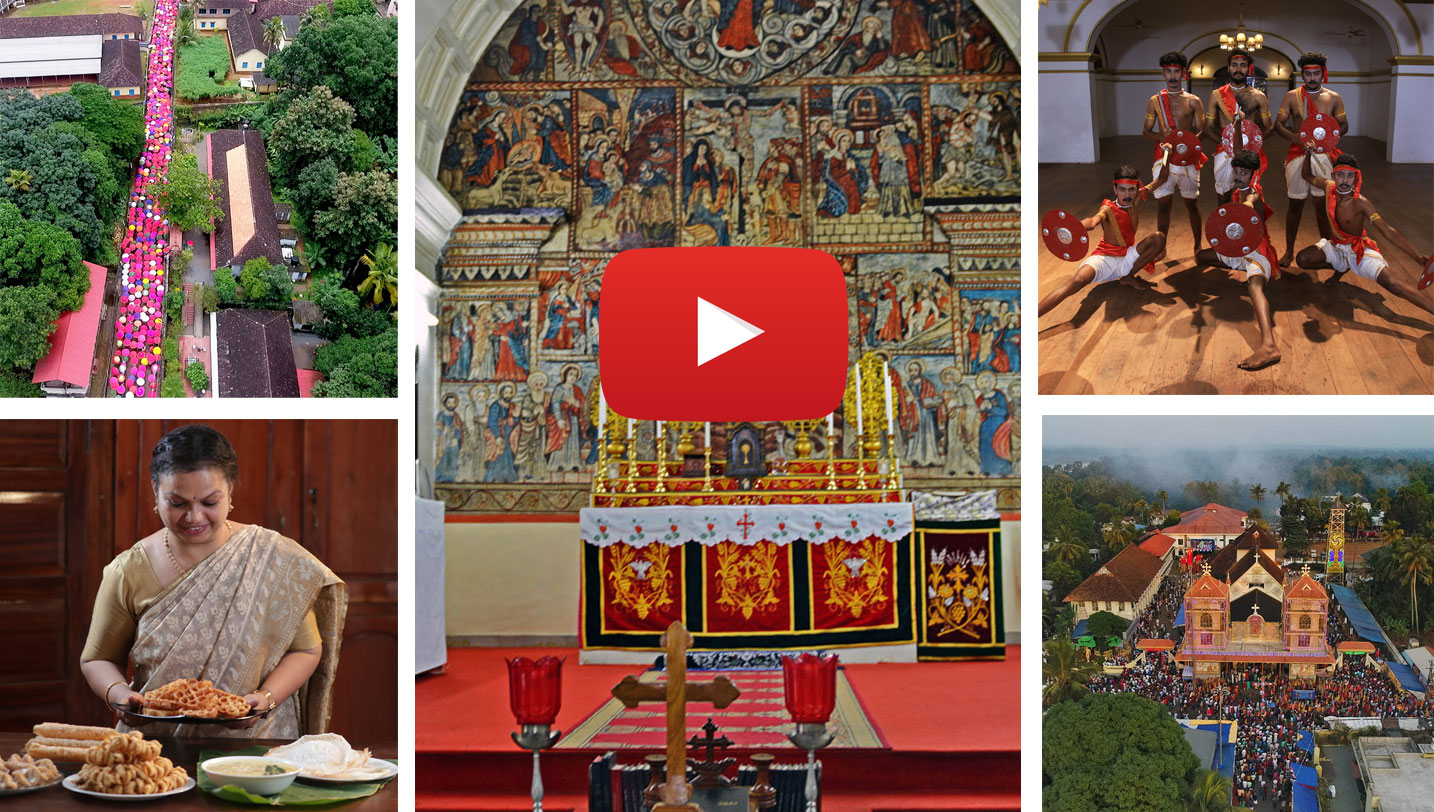Post St. Thomas arrivals
.jpg)
Pantaenus:
Pantaenus, head of the seminary of Alexandria and Metropolitan of Caesarea visited Kerala in CE 190. He was a Christian scholar who lived in Sicily, South Italy, in the second half of the second century. He was a profound scholar of Stoic philosophy. The Stoicism that he practiced held that man should be led by his intelligence and his deeds should develop his mind and intelligence. It resulted in an urge for an energetic and rightful living. Pantaenus has written about finding a prominent presence of Christians. He arrived amidst a community of Christians who were baptized by St. Thomas but was facing extinction.
He argued with them and defeated the scholarly priests of other communities who opposed Christianity and thus strengthened the community. While leaving for Alexandria after a successful mission, the Christians of Kerala presented him with a manuscript of the Gospel of St. Mathew in the Aramaic language which he handed over to the famous University in Alexandria. Historians say that the visit of Pantaenus helped to revive Christianity that was facing the threat of extinction in Kerala. V. Jerome (CE 342 – 420), as well as the historian Eusebius, have written about the visit of Pantaenus. By the fourth century, the Western church got the protection of the rulers, but the churches in Kerala never got such royal patronage. However, when the Western Church had to face the persecution of the rulers during the initial years, St. Thomas Christians did not ever experience persecution.
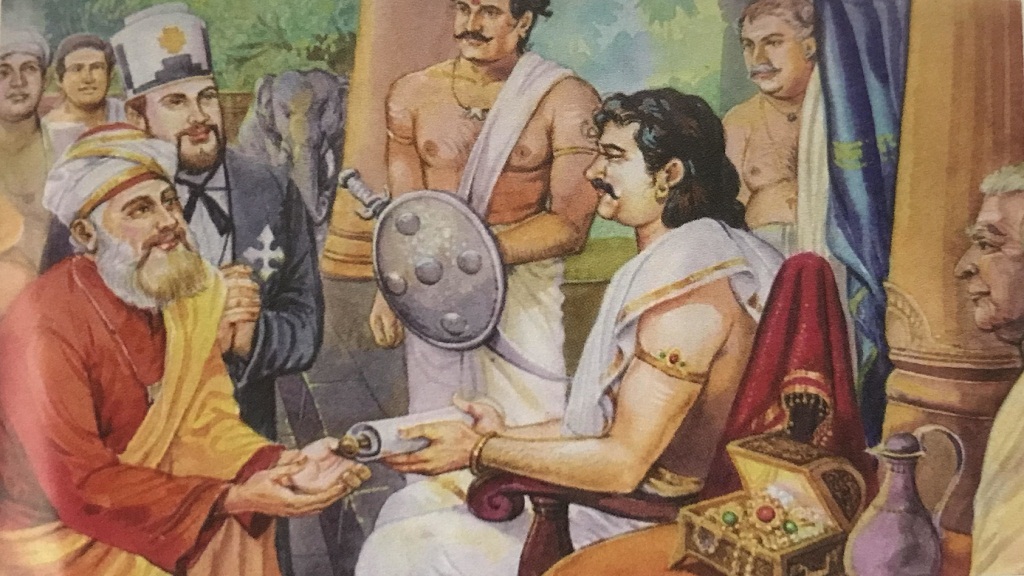
Thomas of Cana receives privileges from Cheraman Perumal
Knai Thoma:
Knai Thoma reached Kerala under the leadership of Bishop Ouseph of Edessa in CE 345 along with 400 members of 72 families in three ships. He came from Cana, a town in southern Mesopotamia, which is about 22 kilometers south of Baghdad.
Cheraman Perumal gave him land for setting up a town and a church. Knai Thoma (Knanya Thoma) and his followers lived in a part of Mahadevar town and its precincts. The part of the town given to him was meant to be the living quarters of the Bishop with Manigramam as the rural extension. On this rural area, Knai Thoma set up a church, constructed his house and other houses, established markets and developed it as a town, and integrated it with Mahadevar town (Bernard, C.F., Mar Thoma Christians). The Chera Kings considered Knai Thoma as the descendant of King David (Ananthakrishna Ayyar, L.K., Anthropology of the Syrian Christians). This highly influential and rich merchant and his companions were also awarded a lot of other benefits and honours too. These included the right for a customary reception to him and his kin with the music of seven instruments in tune with Kerala custom, the right to use a carpet on the floor and a decorated canopy overhead, to ride an elephant, to travel in a palanquin and several more (Joseph, T.K., Malankara Nazranikalude Nalu Cheppedukal). Knai Thoma was also presented with a special crown known as `Venthenmudi,’ in addition to the 72 privileges.
There are historians who feel that his migration helped to alter the way of life of people of other religions too. He secured top positions in the society for members of the Christian community in Kerala. He, being the leader of a large contingent of merchants, put in a lot of effort to popularize foreign trade in Kerala.
.jpg)
Stone cross and stone lamps of Holy Magi Forane Church Manimala
Persian crosses:
It is believed that before the arrival of the Portuguese, churches had no other statues, except the cross, for which the Syriac word Sleeba was used. The fish was used as a symbol in the first centuries. Mosaic pictures bearing five pieces of bread and a fish could be seen all over Israel. This symbol is found inscribed on granite slabs in the churches belonging to the earliest period. The worship of the cross became popular since CE 326, when the cross on which Christ was crucified was discovered.
Some argue that the Persian cross known as Mar Thoma cross is actually Manichean cross. It is true that Persian crosses were not recovered from the churches established by St. Thomas or from Angamaly where the throne of St. Thomas was situated. But Persian crosses (Pahlavi cross) have been recovered from Kottayam, Alangad, Kadamattom, Kothanalloor, Changanassery, Muttuchira, Kanyakumari, Ujjain, Kalyan, Goa (Pilar) and Mylapore. These Pahlavi crosses are the Persian memorials of Christian heritage. There are studies which assert that there are four very old crosses in Kerala. One of them was recovered from Muttachira Catholic church, another from Kadamattom Jacobite church, and two from Kottayam Knanaya Jacobite church (Daniel, Dr. Mathew, Christian Culture). The crosses recovered from other places are those made by the migrant Persian Christians.
The pattern of the crosses also deserves special attention. All the four arms of these crosses are of equal length. And all of them are engraved on granite tablets. A dove descending on it symbolizes the Holy Spirit. Inscriptions in Pahlavi language could be seen below the cross. It has been confirmed that the crosses belong to the eighth century and were worshipped by the descendants of those who migrated from Persia.
A cross that was used as a milestone, known as Alangad cross was found in 1931. Another one, with a lot of similarity with this, recovered from Kothanallor, was earlier used as a step on the northern side of the church. The cross recovered by the Portuguese from Mylapore in CE 1547 and the one installed at the Kottayam Valia Palli are of a similar model and have similar inscriptions too. The cross in Kottayam was recovered in CE 1550 from the ground and reinstalled, according to historical records.
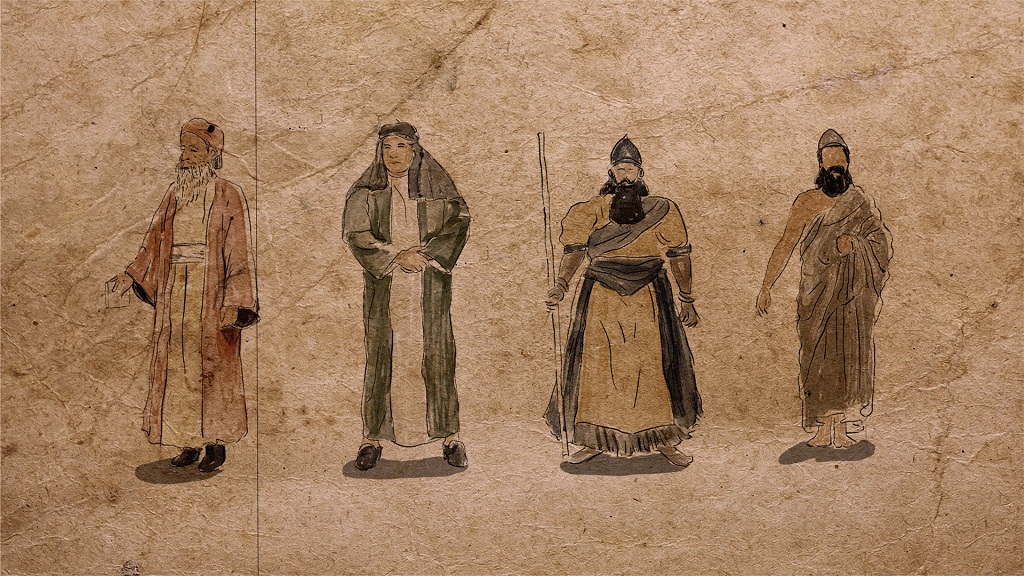
Various traders from around the world
The early travellers:
Venetian trader Marco Polo describes the main destinations in India in CE 1288. He visited the St. Thomas tomb in Mylapore. John of Monte Corvino the first European missionary to visit India in CE 1291 has written about the Christian community in the Madras region here. Bishop John de Marignolli, a member of the Franciscan Church, who was delegated by Pope Clement VI, came to Kollam in CE 1348. He has written about the pepper trade which was the monopoly of the Christian merchants. As the representative of the Pope, he received from the traders, 100 gold coins per month as well as a final gift of 1,000 gold coins before he left India. He stayed here for 16 months at a stretch.
Sea Journeys:
The Renaissance witnessed a spurt in sea journeys in Europe driven by a quest for knowledge, and new lands. Venice, Milan and Rome became rich cities following their spice trade with India. Most of the huge churches in Rome were made with the wealth amassed by this trade. It was the competition with Venice, which was then, as the center of spice trade with India, the richest city in Europe, which prompted the Portuguese to discover a sea route to India. Portugal, the smallest country in Europe, was trying to vie with Spain to conquer the world. Their adventures in the sea were with the patronage of Manuel I, the king of Portugal and Pope Leo X. The sea route to Rome was through Lisbon, and Lisbon became in course of time, the richest city in Europe. Two years after reaching India, in CE 1500, the Portuguese Navy also reached Brazil. The flow of money and goods from two continents enhanced the wealth of Lisbon greatly.
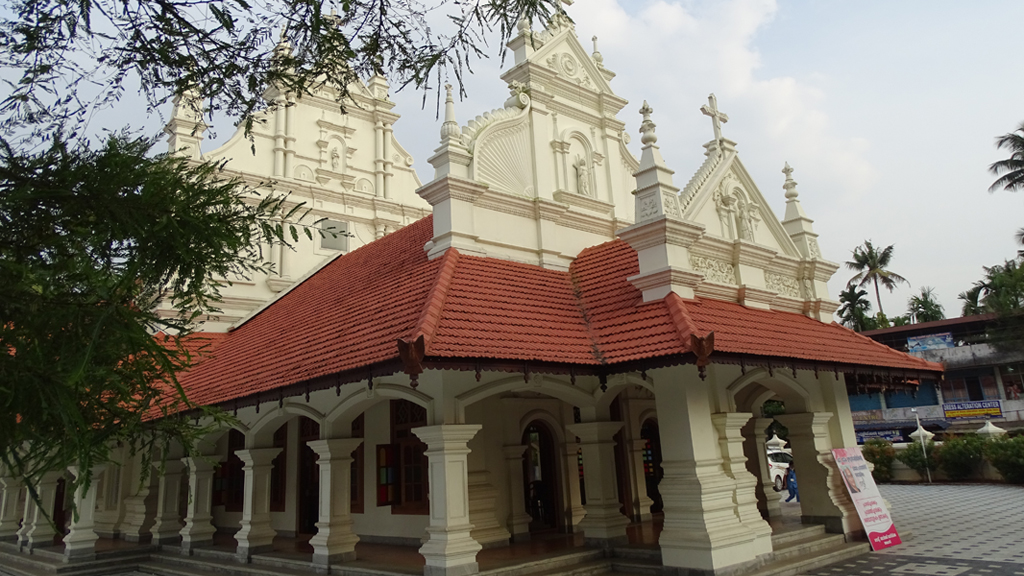
St. Hormis Church, Angamaly
The arrival of the Portuguese:
The colonial rule of India began when Vasco da Gama, at the head of a Portuguese navy, set out to conquer the world, and arrived in Kappadu near Kozhikode in four ships with 170 people, in May 1498, having started his journey from Lisbon, the capital of Portugal in April 1497. Before the advent of da Gama, the ships of Bartolomeu Dias had circumnavigated the Cape of Good Hope in 1488, but could not reach India. The first sea journey of da Gama changed the course of world history. The Portuguese established their sway over the waters of India, Persia, and South China and set the course for colonization.
Da Gama was the captain of the ship, Zan Gabriel. Two ships were lost in the expedition and only 55 men returned to Lisbon. After the first successful mission, da Gama came to India twice more. When he came to India as Viceroy in 1524, he caught malaria while in Goa. He died in Kochi on December 24, 1524. His mortal remains were first buried at the St. Francis church at Fort Kochi and were later taken to Portugal in 1539.
Vasco-da-Gama did not see any of the Christian centers in India on his first visit. After da Gama went back, Cabral reached Kodungalloor in 1500. He made friends with St. Thomas Christians and even took two of them to Europe.
When da Gama reached Kochi with a fleet of 10 ships for his second visit in 1502, the St. Thomas Christians sought his help to protect them from the attack of Muslims. As a mark of their allegiance, they surrendered their symbols of power, the scepter and the citation which were awarded to them by the Perumal Kings, and accepted the suzerainty of da Gama.
When the Portuguese reached India, the control of the spice trade was in the hands of the Nasranis. As many as 30,000 Christian families lived in 20 cities in Kerala during those days, as per records (Angamaly, Varghese, Portuguese Era and Abraham). The Portuguese wanted to expand their trade base among them using religion. Portuguese trade was managed by the official navy of the King of Portugal. Their first mission was to break the Arab’s trade monopoly in the Western Coast. As many as 75 Portuguese, including five priests, were killed in the first attack under Cabral in 1500. Da Gama wreaked vengeance on his second visit in 1502. The Portuguese were able to make the Arabs flee from the Arabian Sea and end the monopoly of the Zamorin too. They also succeeded in bringing under their control the Ormus port in Arabia and blocking the movement of the Arabs. The sea route to India from Baghdad was through Ormus. This port was the main trading centre of slaves from Africa. Now it is known as Bandar Abbas in the Persian Gulf. With the Portuguese navy headed by Alphonso de Albuquerque conquering the Ormus, the Portuguese established the monopoly over the trade through the Arabian Sea, and it continued till 1622. Ormus was a prominent Christian colony till the 16th Century. St. Thomas is believed to have spread Christianity there. In Jornado, a book written by Gouvea, there is a mention about the Arab Christians as well as the Bedouins.
- The Tradition of St. Thomas
- The arrival of St. Thomas
- Seven and half Churches
- Post St. Thomas arrivals
- The scenario before the arrival of Gama
- Missionary Activities
- Descriptions of St. Thomas Christians
- The Padruodo
- Portuguese Forts
- Synod of Diamper
- Latinization of Churches
- Coonan Cross Oath
- Post Koonan Kurissu
- Establishment of churches
- Starting of Seminaries
- Anglo Indians
- Migrations to Malabar
